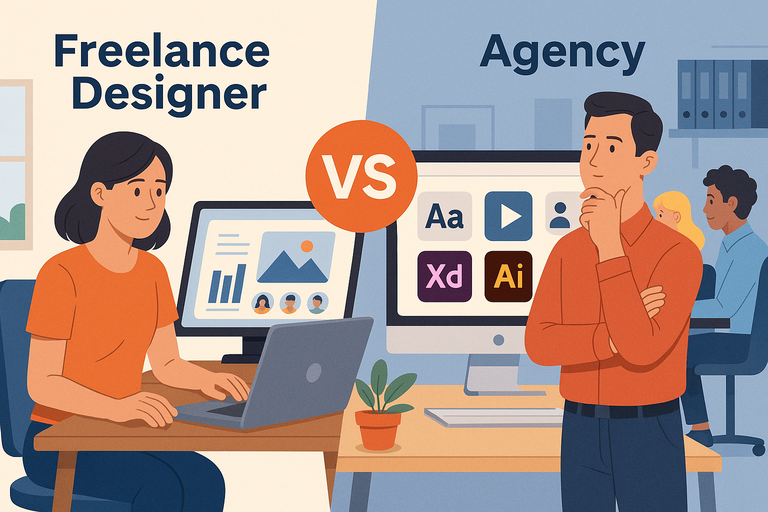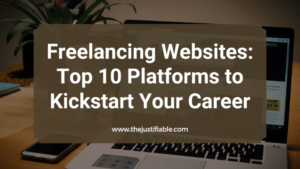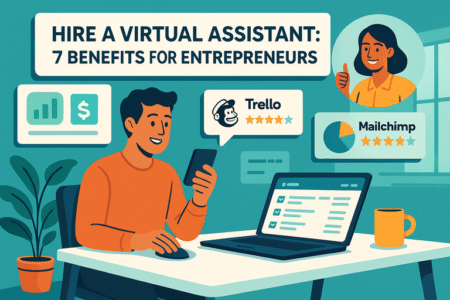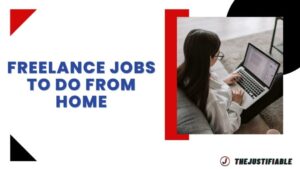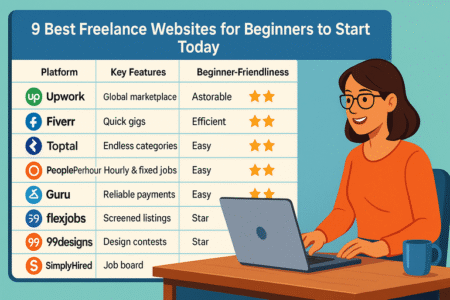Table of Contents
A freelance designer often feels like the hidden gem many businesses overlook. But when your brand needs design support, do you really need a large agency, or could one skilled professional deliver more impact?
This article digs into that question and explains why partnering with a freelance designer may be the smarter move.
Cost Savings That Stretch Your Budget
Hiring a freelance designer often costs significantly less than working with a full-scale agency, and the savings go far beyond just the hourly rate.
When you look closely, it’s the structure of freelancing itself that makes your budget go further.
Lower Overheads Mean Better Rates
An agency has salaries, office rent, administrative staff, and layers of management. A freelance designer doesn’t carry those costs, which means their rates are usually leaner and more competitive.
For example, while an agency might quote $150–$250 per hour, many freelancers with the same level of skill charge $50–$100. That doesn’t mean they’re less talented—it just means they don’t have to cover a boardroom lease.
If you’re a small business, these savings allow you to reallocate funds toward ads, product development, or additional creative work instead of draining your entire budget into design overhead. I’d argue this difference is one of the most practical reasons to work directly with a freelancer.
Flexible Pricing Models That Fit Small and Large Projects
A freelancer can work with you in ways an agency simply can’t. You’ll often find:
- Flat project fees for a logo or website redesign.
- Hourly rates for smaller, ongoing updates.
- Retainer packages for consistent monthly work.
This flexibility is a lifesaver if you’re unsure how much design you’ll need. For instance, you can hire a freelancer for just a few graphics in January, then expand to a full campaign in March—without renegotiating a huge annual contract.
Agencies rarely operate this way, and when they do, it usually comes with hefty minimum commitments.
Avoid Paying for Extras You Don’t Really Need
Agencies often bundle services together—branding, strategy sessions, account management, creative direction—even if you only came in for a simple product catalog design.
With a freelance designer, you pay strictly for what you need. If you only need packaging mockups, that’s all you’ll pay for.
This kind of precision billing saves you from wasting money on things you never asked for. One client of mine once told me they saved almost 40% of their projected design spend in a single year just by cutting out “agency fluff.”
When you strip away the extras, your budget doesn’t just stretch further—it actually works harder.
Direct Communication Without Middlemen
Working with a freelance designer gives you something agencies often struggle to deliver: clear, direct communication.
No project managers, no multiple email threads, no delays while your feedback is filtered through layers of staff.
Talk Directly to the Person Creating Your Designs
With a freelancer, you’re speaking straight to the person actually pushing pixels or sketching concepts. That means no relaying instructions through a middleman who may or may not interpret your vision accurately.
If you’ve ever had to explain the same idea three times to three different agency people, you know how refreshing this feels.
I once had a client send me a voice note describing the vibe they wanted for a social campaign—fun, vibrant, “a little mischievous.”
Within an hour, I sent back a mockup. No back-and-forth approvals, no waiting for the agency’s creative director to weigh in. Just quick, direct collaboration.
Faster Feedback Loops That Keep Projects Moving
When communication is direct, feedback cycles shorten dramatically. Instead of your comments passing through account managers, project managers, and creative leads before reaching the actual designer, you just hop on a call or shoot a message.
That efficiency saves days—sometimes weeks—on project timelines. For businesses working on tight deadlines, this speed can be the difference between launching on time or missing the boat entirely.
Eliminate Miscommunication That Often Happens in Larger Teams
Agencies often suffer from the “telephone game” effect. You say one thing to the project manager, they phrase it differently to the creative director, and by the time it reaches the designer, your vision is diluted.
Freelance designers sidestep this problem. Your ideas land directly with the person making them real, which means fewer misunderstandings and revisions.
Less confusion doesn’t just save time; it preserves creative energy and makes the end result feel much closer to your original vision.
Greater Flexibility in Work Approach
One of the biggest perks of working with a freelance designer is flexibility. You’re not boxed into rigid systems or preset processes. Instead, the workflow can mold around your specific needs.
Custom Workflows That Adapt to Your Business Needs
Every business works differently, and a freelance designer can adapt to your style rather than forcing you into theirs.
For example, if your team already uses tools like Trello, Asana, or even a simple Google Drive folder system, a freelancer can plug right in.
I’ve had clients who preferred Slack updates every morning and others who only wanted a weekly email recap.
With a freelancer, you decide the rhythm. You don’t have to jump through the hoops of “approved processes” that agencies often demand.
Easier to Adjust Project Scope Without Bureaucracy
Business needs change fast. Maybe you start with a logo redesign, but halfway through, you realize you also need branded social media templates.
With an agency, that often means rewriting contracts, waiting for approvals, and sometimes even getting pushed into a new billing cycle.
A freelance designer can pivot on the fly. A quick chat is usually enough to tweak the scope, and the new direction can start right away. This agility saves time and keeps projects moving instead of stuck in red tape.
Ability to Take on Unique, Non-Traditional Requests
Freelancers thrive in the gray areas agencies avoid. If you need an unusual project—like designing custom Twitch overlays, interactive PDFs, or experimental branding assets—a freelancer is often excited to take it on. Agencies sometimes dismiss these requests as “not in scope.”
I’ve personally said yes to projects that blended graphic design with video editing and animation because the client wanted something quirky and bold. Flexibility isn’t just about process—it’s about creativity without limits.
Stronger Personal Investment in Your Project
When you hire a freelance designer, you’re not just another line item in a quarterly revenue report. Your success directly impacts theirs, which naturally leads to deeper investment.
Freelancers Thrive on Reputation and Repeat Clients
Unlike agencies that can lean on their size and brand recognition, freelancers often grow their careers through word of mouth and repeat business.
That means every project matters. Delivering great results isn’t optional—it’s survival.
I once had a client tell me, “I recommend you every time someone asks who designed my site.” That single project turned into four new clients.
This kind of ripple effect is why freelancers pour so much care into each piece of work.
Higher Motivation to Deliver Quality and Creativity
Freelancers know their portfolio is their resume. Every logo, website, or campaign is a chance to showcase their best skills. Because of this, they often go above and beyond.
You’ll notice little touches—extra design variations, thoughtful suggestions, or improved layouts—that weren’t even part of the original brief.
That’s not just about being nice; it’s because freelancers understand that your project is a reflection of their craft.
More Accountability Since Success Reflects on Them Personally
With agencies, accountability can feel diluted. If something goes wrong, it might get brushed off as “the team’s error.” With a freelancer, the responsibility rests entirely with them, which makes accountability stronger.
If a deadline is missed, there’s no hiding behind a hierarchy. That transparency creates a stronger partnership, because you know they’re directly invested in meeting expectations.
Faster Turnaround Times for Projects
When speed matters, working with a freelance designer can feel like hitting fast-forward. Agencies often get bogged down with layers of approvals and scheduling, while freelancers can just get to work.
Simplified Decision-Making Without Agency Bottlenecks
In agencies, even small creative decisions often require sign-offs from managers or creative directors. That slows everything down. A freelancer has the freedom to make decisions on the spot, so work moves quickly from idea to execution.
For example, I’ve had projects where the client approved a concept in the morning, and by evening, the full draft was ready. That kind of pace rarely happens in agencies simply because of the extra decision layers.
More Time Spent on Execution Instead of Internal Meetings
Agencies spend a surprising amount of time in internal meetings—status updates, brainstorming sessions, management reviews. A freelancer doesn’t have that overhead. Their time is spent designing, not reporting.
This means more of your budget is directed toward actual creative work instead of paying for meetings you never see. That’s how projects finish faster and feel more streamlined.
Ability to Prioritize Urgent Deadlines When Needed
Sometimes you need something yesterday. Agencies often work on fixed schedules and can’t bend easily to sudden demands. A freelancer, however, can shift priorities if they know it’s critical.
I’ve had clients call me on a Friday afternoon with an urgent need for trade show graphics. Because I had direct control of my schedule, I was able to deliver before Monday morning.
That kind of responsiveness can be a game-changer for businesses that can’t afford to miss opportunities.
Specialized Expertise You Can Choose
One of the biggest advantages of working with a freelance designer is choice. You’re not locked into whoever an agency assigns you—you get to select someone who truly fits your niche.
Handpick Designers With Skills That Match Your Niche
Freelancers often specialize deeply. Some focus on UI/UX for SaaS products, others on brand identity for food startups, and some even niche down to things like e-commerce product imagery.
That means you can pick a freelance designer whose portfolio speaks directly to your industry.
For example, if you’re launching a coffee brand, wouldn’t you want someone who has already designed packaging for artisanal goods?
That familiarity translates into smarter design decisions because they’ve already seen what resonates with similar audiences.
Access to Innovative Ideas Not Stuck in Agency Templates
Agencies often reuse tried-and-true processes to save time, which can lead to cookie-cutter designs. Freelancers, on the other hand, usually bring fresher ideas because their work is directly tied to their personal style and experimentation.
I’ve had clients come to me after working with agencies, saying everything felt “too corporate.” When I showed them a mood board mixing bold typography with hand-drawn elements, they were surprised at how different and lively their brand could look.
Freelancers aren’t tied to rigid brand playbooks—they can innovate freely.
Option to Build a Network of Specialists for Different Needs
One freelance designer can be the gateway to a whole network of creatives. Many freelancers collaborate with photographers, copywriters, and developers.
That way, you still get a “team” experience, but with more control over who’s involved.
Imagine needing a new logo, a landing page, and some lifestyle product shots. Instead of paying an agency premium, your freelance designer can recommend trusted collaborators—people they’ve already worked with—so you end up with a cohesive result without the extra markup.
Transparent Collaboration and Workflow
When you hire a freelance designer, you don’t have to wonder what’s happening behind the curtain. Most freelancers work with total transparency, so you know exactly where your project stands.
Clear Timelines and Work Processes Shared Upfront
A good freelancer will outline the process before you start. You’ll often see clear stages like:
- Discovery and brief review.
- Initial sketches or mockups.
- Revisions and feedback rounds.
- Final delivery.
This upfront clarity sets expectations so you’re never left guessing when something will be ready. I always share my timeline in a simple Google Doc so clients can see where we are in real time.
Tools and Platforms That Keep You in the Loop
Freelancers often use user-friendly platforms like Trello, Notion, or Figma to collaborate. For example, with Figma, you can literally watch a freelance designer making adjustments live, as if you were sitting next to them.
That kind of transparency is hard to match in agencies, where you usually get a polished reveal after weeks of silence. Seeing progress unfold makes you feel like part of the creative process, not just a spectator.
Fewer Surprises Since Work Is Discussed Openly
Because communication is direct and ongoing, you’re far less likely to be blindsided by a design that misses the mark. Freelancers usually share drafts early and ask for feedback at multiple points.
This back-and-forth reduces revisions and ensures the final product feels aligned with your vision. It’s like building a house where the builder checks in at every stage—you end up with fewer surprises and more satisfaction.
Opportunity to Build Long-Term Relationships
Working with a freelance designer isn’t just about one project—it can evolve into a long-term partnership that makes your creative life much easier.
Develop Trust That Leads to Ongoing Collaboration
Once a freelancer understands your brand, you won’t need to re-explain your vision every time. That trust speeds up new projects because they already know your preferences, tone, and style.
I’ve had clients who started with a small logo project, and years later, I’m still designing their seasonal campaigns. That consistency only happens when trust is built through repeated collaboration.
A Consistent Design Voice Across Multiple Projects
When you stick with one freelance designer, your brand’s look stays cohesive. Everything—from your social graphics to your packaging—feels like it comes from the same creative brain.
This consistency is crucial because scattered design voices can confuse your audience. A long-term freelancer becomes the keeper of your brand’s visual identity, making sure it always looks polished and recognizable.
A Go-To Creative Partner Who Understands Your Brand Deeply
Over time, your freelancer becomes more than just a contractor—they become a partner who knows your brand inside and out.
They’ll start suggesting ideas you didn’t even think of, like seasonal campaign concepts or ways to refresh outdated assets.
This kind of proactive input is rare with agencies, where staff turnover can mean you’re constantly reintroducing your brand to new people. With a freelancer, the relationship deepens, and so does the creativity.
Pro Tip to Apply Right Away
If you’re on the fence, start small. Hire a freelance designer for a single, contained project—like a social media kit or a landing page.
Pay attention to how they communicate, how flexible they are, and whether their designs feel aligned with your brand.
You’ll quickly see if working with them feels more natural than the structured approach of an agency. Often, one small project is enough to realize the value of building an ongoing creative partnership.


